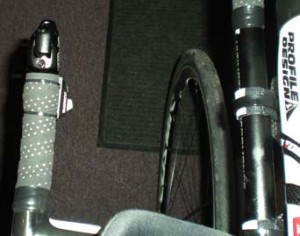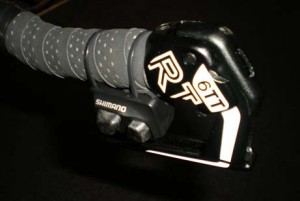Di2 TT/Tri Shifters and Hydraulic Brakes – You Can Have It All!
By Jim Weaver, Lead Technician, Fit Werx, VT
Using aerobar shift levers is generally a bit of a strain, requiring your wrist to flex to sometimes extreme angles in order to shift. In addition, the cable pull requires energy that may be in short supply and the movement disrupts airflow – all compromises to both performance and comfort. With varying degrees of success, some cable-actuated systems (like return-to-center systems) have come on the scene to try to alleviate these problems. However, none of them approach the refinement and ease of using an electronic shifting system; it is hard to get much simpler than pushing a button . In addition to the advantage of the ease of shifting, electronic systems offer the option of having shift button located on the brake levers as well as at the end of the aerobar extensions. However, a problem arises when you want to run hydraulic brakes (like on Cervelo’s P5) and you want brake lever mounted shift levers – Shimano does not offer this. We recently faced this quandary when converting an athlete’s Cervelo P5 over to Di2.
The first option was to just switch the brakes to cable brakes and use Shimano’s integrated Di2 TT brake levers? Well, if you have used the Magura RT6 TT hydraulic rim brakes, you know why you don’t want to make that change. The Magura RT brakes work great, particularly in the rear of a TT/Tri bike, and are the most powerful road brakes I have ever used. So, he did not want to lose that braking performance, but he wanted the additional shift position on the brake lever. So, a little creativity was required to achieve both goals. Shimano makes optional climbing buttons for their road shift levers that are designed to mount on the flat top of the handlebars, near the stem. I thought that with some modification these could be made to work well as remote shift buttons on a TT/Tri bike. So, I got to work…
The first problem was that the cable that connects the button to the wiring junction is far too short to use in this application. So, I needed to splice cables together to make a cable long enough to reach the junction box that operates the entire system. I have spliced together previous generation Dura Ace Di2 cables, and it is not easy as the rubber outer covering of the cables is very tough, needing to be waterproof, and the wires inside the cable are fine. However, with more patience than I usually exhibit, I was able to splice them. After this, it was a matter of running the cables through the handlebars to reach the cable junction box that mounts underneath the stem. Simple to say, not quite as simple to do. I could have run the cables outside and underneath the bar, a far easier installation, but not as neat and tidy or as aero or well protected from the elements. So, inside the bar they went…
Once the cabling was complete, all that was left was to see if the buttons actually worked and then to program what they do. The Di2 system allows for shifters to be programmed to operate either the front or rear derailleurs, and the shift buttons can be assigned to either shift up or down, whichever ever you prefer. I connected the bike to Shimano’s computer interface and programmed the new shift buttons. Voila, very functional shifters by the brake levers.
Upon installation, I was concerned that the shift buttons would interfere with the brake levers, as you might imagine from the pictures. However, this ended up not being the case. The Magura brake levers have an excellent range of lever adjustment, and the brakes on this bike are fully applied without the lever touching the shifters. 
Because of the complications in routing hydraulic brake lines and shift wires together, the entire installation took several hours. However, it will likely go quicker the next time and the result worked quite well; he now has the incredible shifting performance of the best TT shifting system on the market and the best performing rim brakes too. While not quite as elegant as Shimano’s integrated reverse lever with Di2 shifters, this athlete’s bike has the same shifting capability as that integrated lever, plus the better braking performance of the Magura hydraulic brakes. After all, good shifting is important, but so is stopping!

